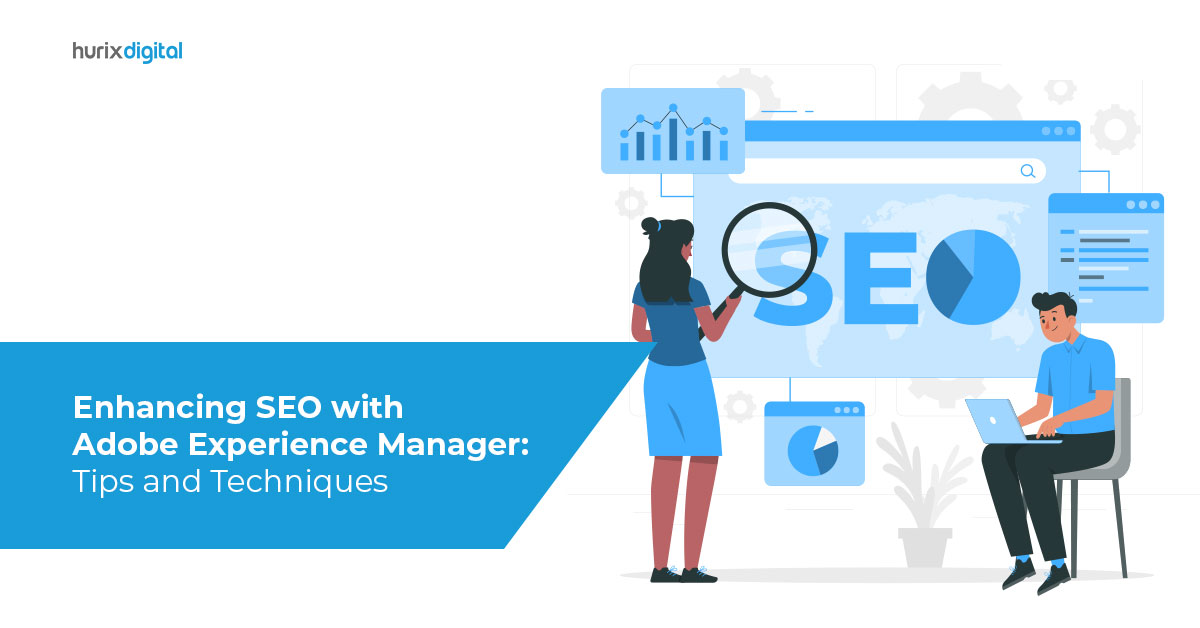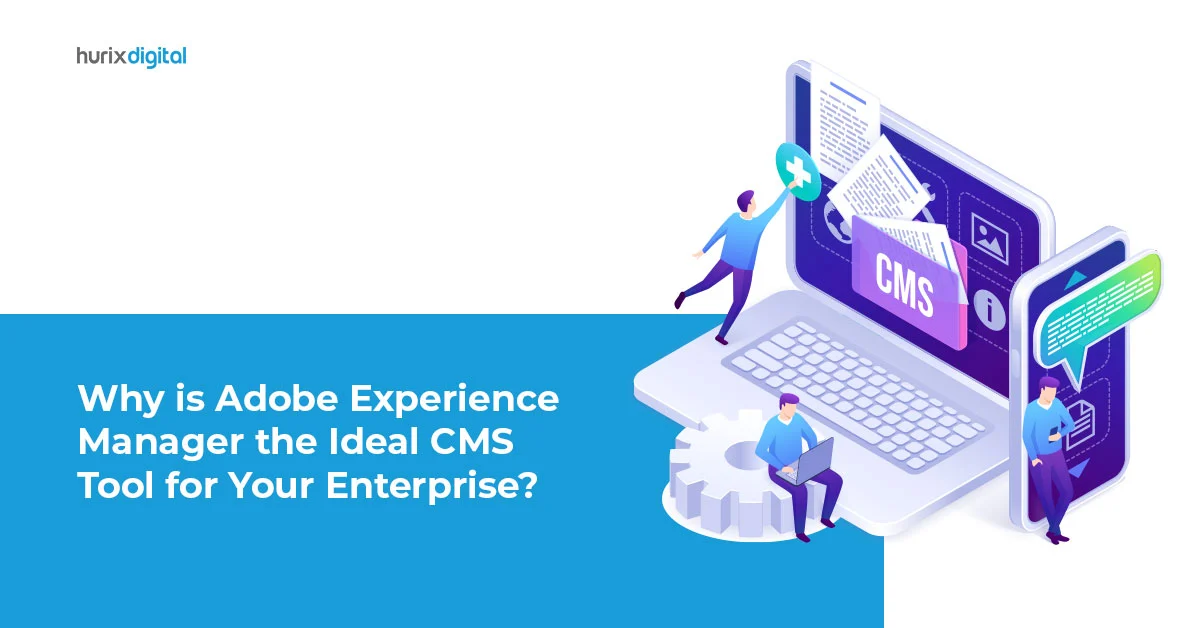
Enhancing SEO with Adobe Experience Manager: Tips and Techniques
Summarize with:
Aligning the needs of your digital marketing and product teams while effectively translating those requirements into actionable development tasks successfully hinges on your ability to harness the full potential of your content management system (CMS) or find clever workarounds for any missing features.
Search engine optimization (SEO) is pivotal in the success of any website. There is a 14.6% closure rate for SEO leads.
A powerful ally like Adobe Experience Manager (AEM) empowers you to efficiently construct and maintain high-traffic websites, digital assets, and mobile applications.
Table of Contents:
- Getting Started with Adobe Experience Manager (AEM)
- Boosting SEO with AEM: Powerful Features for Enhanced Online Visibility
1. Optimize Content with Keywords
2. Implement Responsive Design
3. Leverage SEO Analytics
4. Leverage SEO-Friendly URLs
5. Optimize Page Titles and Meta Descriptions
6. Optimize Page Loading Speed - The Bottom Line
Getting Started With Adobe Experience Manager (AEM)
AEM assets can handle your needs, whether you work with a small website or a vast one with hundreds of thousands of pages. Organizations can effectively manage their marketing content from a centralized dashboard and distribute it across multiple channels.
AEM offers a wealth of features harnessing which your website’s SEO efforts can soar to new heights. But here is the thing: even with AEM’s built-in features, a solid SEO strategy remains paramount for achieving remarkable results.
By addressing your strategy early on, you can seamlessly integrate it with AEM’s capabilities to unlock the potential of your website.
Also Read: AEM For E-Commerce: The Future Of Online Retail
Boosting SEO with AEM: Powerful Features for Enhanced Online Visibility
This overview shall take you on a guided tour through AEM’s core capabilities and SEO-specific features. These capabilities and features will shape the success of your online presence and propel your brand’s digital marketing initiatives forward.
1. Optimize Content with Keywords
Keywords remain a cornerstone of SEO, and with AEM’s powerful content management capabilities, integrating target keywords into your content becomes a seamless task. Conduct comprehensive keyword research, identifying relevant terms that align with your content to realize the full potential of SEO.
Strategically incorporate SEO components and keywords organically throughout your headlines, body text, and image alt tags. However, it is crucial to avoid keyword stuffing, as this practice is detrimental to your search engine rankings.
2. Implement Responsive Design
Adobe Experience Manager (AEM) offers a realm of responsive web design, unlocking a new level of user engagement. With powerful AEM assets like layout mode and the emulator tool, you become the architect of a seamless, device-friendly browsing experience.
Gone are the days of labor-intensive development tasks and clunky mobile interfaces. AEM allows you to take control of display configuration. Now, you can seamlessly drag and drop components, shaping your pages to adapt flawlessly across different devices.
The emulator tool enables previewing your page layout and fine-tuning its design to perfection for the devices your users interact with. It enhances the user experience while signaling to search engines that your website is optimized for mobile use. This gives you an edge in search rankings.
By leveraging AEM’s responsive page design capabilities, search engines like Google take notice, helping you stay ahead of the game and ensuring your online presence stands apart.
3. Leverage SEO Analytics
AEM and Adobe Analytics integration bring a remarkable opportunity to connect data and content, enhancing your website’s impact. Users may structure their content for optimal engagement through Adobe AEM.
They might also leverage the data mining capabilities of Adobe Analytics to create a customized, scalable website experience. This seamless fusion improves transparency and visibility, enables understanding of visitor behavior, and leads to effective lead generation.
The integration empowers businesses to gain a comprehensive view of the customer journey. This allows effective lead generation and boosting page conversion rates effortlessly. According to 71% of marketers, incorporating strategic keywords is their top SEO marketing tactic.
Monitoring key metrics such as organic traffic, keyword rankings, and tracking page activity, form submissions, link clicks, and transaction data becomes a breeze, offering targeted experiences for individual customers or user groups.
With integration capabilities, companies can leverage immense data resources to reveal profound actionable insights. It empowers developers and businesses to refine their approach and make data-driven decisions while continuously improving their marketing SEO performance.
4. Leverage SEO-Friendly URLs
The URL organization on your website significantly impacts the user experience and how well it performs in search engines. You can create clear, SEO-friendly URLs with AEM that perfectly capture the core of your content.
You may create an effortless browsing experience for content administrators and visitors by incorporating relevant keywords in your URLs and avoiding long, convoluted addresses. The effectiveness of keywords in URLs declines as URL length and keyword placement rise.
In other words, conciseness is preferable. It is advisable to avoid nesting pages too deeply because shorter URLs tend to fare better in SEO rankings. Utilize AEM assets, tools, and approaches for URL shortening to eliminate extraneous components.
5. Optimize Page Titles and Meta Descriptions
Crafting compelling page titles, meta descriptions, relevant content tailored to your target audience, and incorporating strategic keywords without overstating is fundamental for SEO success. With AEM, your online content assets undergo a thorough scanning process where tags and metadata are automatically assigned.
However, collaborating with an AEM partner or SEO experts who can optimize your content by attaining optimal web metrics and enhancing your site ranking can prove beneficial. Organize your content using header tags to boost readability and signal importance.
Elevate your images by giving them descriptive titles and alt tags, enabling better visibility in image search results. Ensure your SEO title is concise, descriptive, and includes relevant keywords. Meta descriptions should entice users to click by providing a compelling summary of the page content.
6. Optimize Page Loading Speed
There has been a constant rise in the amount of time people spend online as the internet continues to grow at mind-boggling rates. This makes it more crucial than ever for businesses to create streamlined user interfaces that present information effectively and unobtrusively.
Minification helps shrink file sizes requested from the server, although most libraries are not minified by default. AEM features a service to enable minification, which decreases the size of JavaScript (JS) files requested, ultimately enhancing page loading speed.
Users can actively minimize page load times, improving user satisfaction and the prospects of appearing higher in search results. All this is thanks to AEM’s built-in tools for optimizing page performance, including image compression and caching.
Also Read: AEM Solutions: The Key to Efficient, Effective Government Operations and Citizen Engagement
The Bottom Line
Enhancing your search engine rankings is an ongoing journey that demands dedication and optimization. Encompassing powerful tools and capabilities, AEM addresses all aspects of digital experience creation and optimization by transcending the boundaries of traditional website management.
This holistic solution empowers organizations to embrace a more strategic and integrated marketing SEO approach and customer experience. Adhering to the best practices outlined in this guide can elevate your search engine rankings, attract more visitors, and secure greater online visibility. It is crucial to continuously monitor your website’s analytics and adapt your SEO efforts and strategy to stay ahead of the competition.
Whether you are amid optimization or implementing your AEM solution, you can count on Hurix’s Adobe AEM Solution partner to collaborate with you to design, execute, and deliver highly personalized multi-channel digital experiences. Take the next step towards realizing your SEO vision now with Hurix!
Also Read – 5-Step Guide to Accelerating Your Digital Journey with Adobe Experience Manager and AWS
Summarize with:

 A Space for Thoughtful
A Space for Thoughtful 



